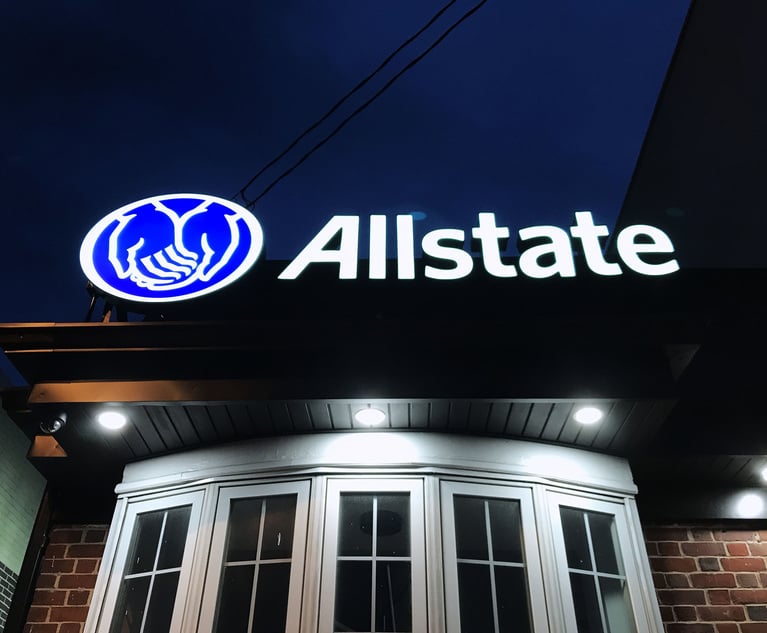Newest Justices Question Feds' Use of America Invents Act
Justices Kavanaugh and Gorsuch led the charge against construing government as "person" who can petition for patent validity review under AIA. Other justices described patent owner's theory as a "fiction" during arguments in Return Mail v. U.S. Postal Service.
February 19, 2019 at 06:08 PM
5 minute read
The original version of this story was published on National Law Journal
 Supreme Court Justices Neil Gorsuch and Brett Kavanaugh.
Supreme Court Justices Neil Gorsuch and Brett Kavanaugh.
The newest members of the Supreme Court continued to assert themselves in patent cases Tuesday, but it wasn't clear whether their views will garner a majority in Return Mail v. U.S. Postal Service.
The question in Return Mail is whether the government is a “person” within the meaning of the America Invents Act (AIA), and can therefore attack the validity of patents in covered business method review proceedings at the U.S. Patent and Trademark Office.
“You've said the context [of the AIA] supports you,” Justice Brett Kavanaugh told Deputy Solicitor General Malcolm Stewart. “But there are contextual points that seem to cut the other way.”
In particular, Kavanaugh noted that the America Invents Act estops petitioners from raising the same arguments made at the PTO in subsequent district court or International Trade Commission litigation. But the AIA makes no mention of estoppel at the Court of Federal Claims, which is where the government defends patent litigation. That would indicate Congress wasn't imagining the government as an AIA petitioner, he suggested.
Justice Neil Gorsuch said the estoppel point becomes “just even a little odder still” when an executive branch agency would be acting as both a petitioner and the decision maker in the PTO proceedings. “Isn't it a little unseemly to say that the executive branch shouldn't be bound by its own decisions?” Gorsuch asked.
Gorsuch has already penned a majority opinion and two dissents in patent cases, while Kavanaugh was an active questioner in this term's only other patent dispute.
It was by no means clear that their views would prevail. Chief Justice John Roberts and Justice Samuel Alito both suggested it was a “fiction” that Congress considered the implications of using the word “person” when crafting the AIA. And Justices Stephen Breyer and Ruth Bader Ginsburg, in her return from an illness, noted that the overarching purpose of the law was to remove invalid patents from the system.
“Why would Congress want to leave a government agency out of this second look if the idea is to weed out patents that never should been given in the first place?” Ginsburg asked Covington & Burling partner Beth Brinkmann, representing patent owner Return Mail Inc.
“Because the government already has opportunities” to remove patents via the ex parte re-examination process and in Court of Federal Claims proceedings, Brinkmann said.
The AIA states that “a person who is not the owner of patent” may petition for inter partes review (IPR) of a patent, and any person sued for infringement may petition for covered business method (CBM) review. Both are administrative procedures for reconsidering patent validity at the PTO.
Corporations are generally understood to be “persons” under the law. In a dissenting opinion at the Federal Circuit, Judge Pauline Newman argued that under Supreme Court precedent, “person” should be presumed to exclude the United States and its agencies.
Brinkmann made that same case Tuesday at the Supreme Court. She argued that the government can still challenge patent validity by asking the PTO director to exercise his discretion to launch an ex parte re-examination.
That part of her argument didn't sit well with the chief justice. “What is the director of the PTO supposed to do when he gets one of these calls from the government [saying] we want you to re-examine this?” he asked. “Is he or she supposed to make an independent determination, or is he or she supposed to salute and go ahead and do it?”
Alito questioned whether the court should indulge “the possible fiction that Congress actually gave a second of thought to the issue that's before us” when it used the word person.
Justice Elena Kagan echoed his concern. “Does anybody really think Congress thinks about this as a default rule and legislates against it?” she said. “And if not, shouldn't we just do what strikes us as the thing Congress would have wanted done?”
If the answer to Kagan's question turns out to be yes, it will have implications well beyond the Return Mail case, said Holwell Shuster & Goldberg counsel Karen Sebaski, a lawyer who has been following the case who reviewed Tuesday's transcript. “I do think the court signaled it could be ready to revisit the relative strength of the default rule,” she said. “The court signaled a desire to focus on real-world implications” when construing “person.”
She described the questioning as tough on both sides, with the court trying to discern any reason for treating the government differently on one hand. “And then on the other hand, I think they're likely to focus on the implication of having a different estoppel rule for the government than for private parties.”
Ropes & Gray partner Matthew Rizzolo, who has also been following the case, said he wasn't surprised to see Kavanaugh—who's written about intra-executive conflicts before—and Gorsuch lead the charge on behalf of Return Mail. If Return Mail and the estoppel argument prevail, he expects Kavanaugh to have his first majority opinion in a patent case.
“Personally, that's an argument I've always found pretty persuasive,” he said. “It's something pretty tangible.”
This content has been archived. It is available through our partners, LexisNexis® and Bloomberg Law.
To view this content, please continue to their sites.
Not a Lexis Subscriber?
Subscribe Now
Not a Bloomberg Law Subscriber?
Subscribe Now
NOT FOR REPRINT
© 2025 ALM Global, LLC, All Rights Reserved. Request academic re-use from www.copyright.com. All other uses, submit a request to [email protected]. For more information visit Asset & Logo Licensing.
You Might Like
View All

DOJ, 10 State AGs File Amended Antitrust Complaint Against RealPage and Big Landlords
4 minute read
Apple Agrees to Pay $95 Million Settlement in Siri Voice Assistant Privacy Class Action

Pre-Internet High Court Ruling Hobbling Efforts to Keep Tech Giants from Using Below-Cost Pricing to Bury Rivals
6 minute readTrending Stories
- 1'A Death Sentence for TikTok'?: Litigators and Experts Weigh Impact of Potential Ban on Creators and Data Privacy
- 2Bribery Case Against Former Lt. Gov. Brian Benjamin Is Dropped
- 3‘Extremely Disturbing’: AI Firms Face Class Action by ‘Taskers’ Exposed to Traumatic Content
- 4State Appeals Court Revives BraunHagey Lawsuit Alleging $4.2M Unlawful Wire to China
- 5Invoking Trump, AG Bonta Reminds Lawyers of Duties to Noncitizens in Plea Dealing
Who Got The Work
J. Brugh Lower of Gibbons has entered an appearance for industrial equipment supplier Devco Corporation in a pending trademark infringement lawsuit. The suit, accusing the defendant of selling knock-off Graco products, was filed Dec. 18 in New Jersey District Court by Rivkin Radler on behalf of Graco Inc. and Graco Minnesota. The case, assigned to U.S. District Judge Zahid N. Quraishi, is 3:24-cv-11294, Graco Inc. et al v. Devco Corporation.
Who Got The Work
Rebecca Maller-Stein and Kent A. Yalowitz of Arnold & Porter Kaye Scholer have entered their appearances for Hanaco Venture Capital and its executives, Lior Prosor and David Frankel, in a pending securities lawsuit. The action, filed on Dec. 24 in New York Southern District Court by Zell, Aron & Co. on behalf of Goldeneye Advisors, accuses the defendants of negligently and fraudulently managing the plaintiff's $1 million investment. The case, assigned to U.S. District Judge Vernon S. Broderick, is 1:24-cv-09918, Goldeneye Advisors, LLC v. Hanaco Venture Capital, Ltd. et al.
Who Got The Work
Attorneys from A&O Shearman has stepped in as defense counsel for Toronto-Dominion Bank and other defendants in a pending securities class action. The suit, filed Dec. 11 in New York Southern District Court by Bleichmar Fonti & Auld, accuses the defendants of concealing the bank's 'pervasive' deficiencies in regards to its compliance with the Bank Secrecy Act and the quality of its anti-money laundering controls. The case, assigned to U.S. District Judge Arun Subramanian, is 1:24-cv-09445, Gonzalez v. The Toronto-Dominion Bank et al.
Who Got The Work
Crown Castle International, a Pennsylvania company providing shared communications infrastructure, has turned to Luke D. Wolf of Gordon Rees Scully Mansukhani to fend off a pending breach-of-contract lawsuit. The court action, filed Nov. 25 in Michigan Eastern District Court by Hooper Hathaway PC on behalf of The Town Residences LLC, accuses Crown Castle of failing to transfer approximately $30,000 in utility payments from T-Mobile in breach of a roof-top lease and assignment agreement. The case, assigned to U.S. District Judge Susan K. Declercq, is 2:24-cv-13131, The Town Residences LLC v. T-Mobile US, Inc. et al.
Who Got The Work
Wilfred P. Coronato and Daniel M. Schwartz of McCarter & English have stepped in as defense counsel to Electrolux Home Products Inc. in a pending product liability lawsuit. The court action, filed Nov. 26 in New York Eastern District Court by Poulos Lopiccolo PC and Nagel Rice LLP on behalf of David Stern, alleges that the defendant's refrigerators’ drawers and shelving repeatedly break and fall apart within months after purchase. The case, assigned to U.S. District Judge Joan M. Azrack, is 2:24-cv-08204, Stern v. Electrolux Home Products, Inc.
Featured Firms
Law Offices of Gary Martin Hays & Associates, P.C.
(470) 294-1674
Law Offices of Mark E. Salomone
(857) 444-6468
Smith & Hassler
(713) 739-1250






